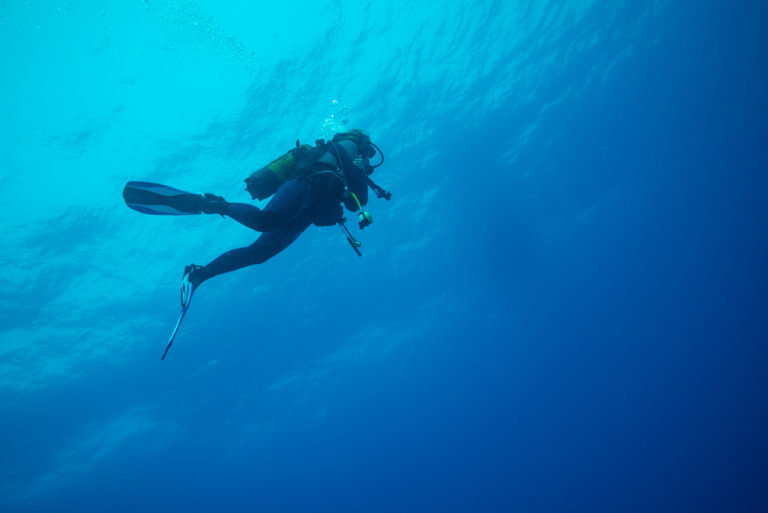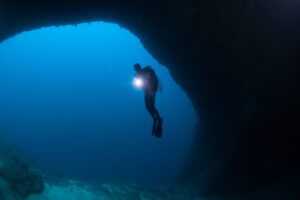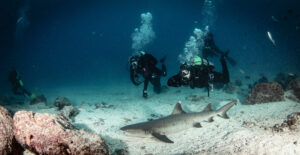What is a Gas Embolism?
A gas embolism is a serious medical condition that can occur when gas bubbles enter the bloodstream and obstruct blood vessels. This condition is particularly relevant to scuba divers due to the unique pressures and environments encountered underwater. When a diver ascends too quickly or experiences equipment failure, gas bubbles can form within the blood vessels, leading to potentially life-threatening complications. Understanding gas embolism within the context of scuba diving involves recognizing how these gas bubbles form, their impact on the body, and the measures necessary to prevent and treat this condition.
Understanding Gas Embolism
Gas embolism refers to the presence of gas bubbles in the bloodstream, which can obstruct blood flow and cause significant physiological disturbances. In scuba diving, this typically happens during a rapid ascent, where the decrease in pressure allows dissolved gases, primarily nitrogen, to come out of solution and form bubbles. These bubbles can travel through the bloodstream and lodge in various tissues, causing damage and potentially life-threatening conditions.
There are two main types of gas embolism: arterial gas embolism (AGE) and venous gas embolism (VGE). Arterial gas embolism occurs when gas bubbles enter the arterial circulation, which can block blood flow to vital organs, including the brain, heart, and lungs. This can lead to severe symptoms such as chest pain, difficulty breathing, stroke-like symptoms, and even loss of consciousness. Venous gas embolism, on the other hand, occurs when gas bubbles enter the venous system. While generally less severe than AGE, VGE can still cause significant complications, particularly if the bubbles pass through the lungs and into the arterial circulation.
Understanding the underlying physiology of gas embolism helps to highlight the critical nature of this condition in scuba diving. The body’s response to these gas bubbles can be severe, and prompt recognition and treatment are essential to prevent long-term damage or fatality.
Causes and Risk Factors
Gas embolism in scuba divers is primarily caused by rapid ascent, where the decrease in ambient pressure causes dissolved gases in the blood to form bubbles. This rapid ascent can result from various scenarios, such as panic, equipment failure, or poor buoyancy control. When a diver surfaces too quickly, the pressure changes do not allow sufficient time for the gas to safely come out of solution, leading to the formation of dangerous bubbles.
Several risk factors can increase the likelihood of a gas embolism. Depth and duration of the dive are significant factors; deeper and longer dives increase the amount of gas dissolved in the blood, raising the risk during ascent. The rate of ascent is also crucial; a controlled and slow ascent allows gases to be safely expelled from the body. The composition of the breathing gas, such as the use of mixed gases in technical diving, can also influence the risk. For instance, gases with a higher proportion of nitrogen increase the potential for nitrogen bubble formation.
Pre-existing health conditions can further exacerbate the risk of gas embolism. Conditions such as lung diseases, cardiovascular problems, and patent foramen ovale (a heart defect that allows gas bubbles to pass from the venous to the arterial system) can significantly increase the danger. Additionally, dehydration, fatigue, and alcohol consumption can impair the body’s ability to manage dissolved gases and increase susceptibility to gas embolism.
Symptoms and Diagnosis
The symptoms of gas embolism can vary widely depending on the location and size of the gas bubbles, but they often have a rapid onset following a dive. Common symptoms include chest pain, shortness of breath, confusion, and weakness. If the brain is affected, symptoms can mimic a stroke, such as paralysis, dizziness, or seizures. When the heart is involved, arrhythmias or cardiac arrest can occur. Divers may also experience visual disturbances, unconsciousness, or even death in severe cases.
Diagnosis of gas embolism requires a combination of clinical assessment and diagnostic tools. Initial evaluation focuses on the diver’s symptoms, history of the dive, and ascent profile. Imaging techniques such as computed tomography (CT) scans and magnetic resonance imaging (MRI) are crucial for detecting gas bubbles in the bloodstream and identifying affected areas. Doppler ultrasound can be used to detect bubbles in the veins and arteries, particularly in cases of venous gas embolism. Blood tests may also be performed to assess the extent of hypoxia or other metabolic disturbances caused by the embolism.
Prompt and accurate diagnosis is vital for effective treatment and minimizing long-term damage. Medical professionals trained in dive medicine can provide specialized care and ensure that the appropriate diagnostic tools are utilized to confirm the presence of gas embolism.
Prevention Strategies
Preventing gas embolism is a key aspect of safe scuba diving practices. Effective prevention strategies focus on dive planning, proper ascent techniques, and adherence to safety protocols. One of the most critical preventive measures is to plan dives carefully, considering depth, duration, and decompression stops. Dive computers and tables are essential tools that help divers plan their ascents to avoid rapid pressure changes.
Controlled ascent rates are paramount in preventing gas embolism. Divers are advised to ascend slowly, typically no faster than 9 meters (30 feet) per minute, and to make safety stops at 3 to 6 meters (10 to 20 feet) for three to five minutes, even if their dive profile does not strictly require it. These safety stops allow excess nitrogen to be expelled from the body gradually, reducing the risk of bubble formation.
Proper breathing techniques and equipment maintenance also play significant roles in prevention. Divers should avoid holding their breath during ascent, as this can lead to over-expansion of the lungs and increase the risk of gas bubbles entering the bloodstream. Regular maintenance and checks of diving equipment, particularly regulators and buoyancy control devices, ensure that divers can manage their buoyancy effectively and avoid uncontrolled ascents.
Education and training are essential components of gas embolism prevention. Divers should undergo thorough training in dive physiology, decompression theory, and emergency procedures. Understanding the risks and recognizing the early signs of gas embolism can lead to prompt action and reduce the likelihood of severe outcomes.
Management and Treatment
Immediate response to suspected gas embolism is crucial to improving outcomes and reducing the risk of long-term damage or death. The first step in managing a suspected gas embolism is to administer 100% oxygen to the affected diver. This helps to reduce the size of the gas bubbles and improve oxygen delivery to tissues that may be deprived of blood flow due to the embolism. Divers should be positioned in a supine position to facilitate blood flow and reduce the likelihood of further embolization.
The primary treatment for gas embolism is hyperbaric oxygen therapy (HBOT). This involves placing the affected diver in a hyperbaric chamber where they breathe 100% oxygen at increased atmospheric pressures. HBOT helps to reduce the size of the gas bubbles more effectively and promotes reabsorption of the gas into the bloodstream. The increased pressure also enhances oxygen delivery to tissues, aiding in the recovery of damaged areas.
In addition to HBOT, supportive medical care is often necessary. This may include intravenous fluids to maintain blood pressure and hydration, medications to manage pain and other symptoms, and close monitoring of vital signs and neurological status. In severe cases, advanced life support measures may be required, including mechanical ventilation or cardiac support.
Timely medical intervention is critical for minimizing the impact of gas embolism. Divers experiencing symptoms should seek emergency medical attention immediately, as delays in treatment can result in more severe complications and a poorer prognosis. Coordination with dive medicine specialists and hyperbaric facilities ensures that affected divers receive the best possible care.
Impact on Diving Safety
The understanding and management of gas embolism have significantly influenced diving safety protocols and equipment over the years. The development and widespread use of dive computers have revolutionized how divers plan and monitor their ascents. These devices provide real-time data on depth, ascent rate, and decompression stops, helping divers adhere to safe ascent profiles and reduce the risk of gas embolism.
Advancements in diving equipment, such as improved buoyancy control devices and more reliable regulators, have also contributed to safer diving practices. These innovations allow divers to maintain better control over their ascent rates and buoyancy, preventing rapid ascents that could lead to gas embolism. Additionally, the increased availability and accessibility of hyperbaric chambers around the world have improved the outcomes for divers who experience gas embolism by providing timely and effective treatment.
Dive training organizations have incorporated comprehensive education on gas embolism into their certification programs. Divers are now more aware of the risks and the importance of adhering to safe diving practices. Training emphasizes the importance of proper dive planning, controlled ascents, and immediate response to symptoms, all of which contribute to reducing the incidence of gas embolism.
The integration of these safety measures and technological advancements underscores the importance of continuous improvement in diving practices. As our understanding of gas embolism and its prevention evolves, so too do the strategies and tools used to ensure the safety and well-being of divers.
Key Takeaways
Gas embolism is a serious and potentially life-threatening condition that can occur in scuba diving when gas bubbles obstruct blood flow. Understanding its causes, symptoms, and treatment is essential for preventing and managing this condition. Preventive strategies, including careful dive planning, controlled ascent rates, and proper equipment maintenance, play a critical role in reducing the risk. Immediate medical response and hyperbaric oxygen therapy are crucial for treating affected divers. Advances in diving technology and education have significantly improved diving safety, highlighting the importance of continuous adherence to safe diving practices.

















